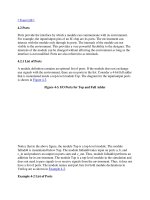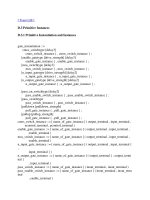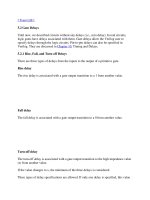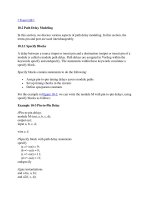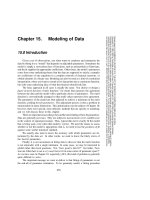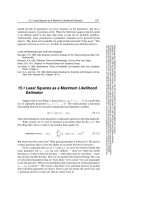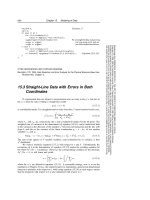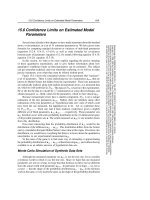Tài liệu User Defined Primitives part 2 pptx
Bạn đang xem bản rút gọn của tài liệu. Xem và tải ngay bản đầy đủ của tài liệu tại đây (26.71 KB, 6 trang )
[ Team LiB ]
12.3 Sequential UDPs
Sequential UDPs differ from combinational UDPs in their definition and behavior.
Sequential UDPs have the following differences:
• The output of a sequential UDP is always declared as a reg.
• An initial statement can be used to initialize output of sequential UDPs.
• The format of a state table entry is slightly different.
• <input1> <input2> <inputN> : <current_state> : <next_state>;
• There are three sections in a state table entry: inputs, current state, and next state.
The three sections are separated by a colon (:) symbol.
• The input specification of state table entries can be in terms of input levels or edge
transitions.
• The current state is the current value of the output register.
• The next state is computed based on inputs and the current state. The next state
becomes the new value of the output register.
• All possible combinations of inputs must be specified to avoid unknown output
values.
If a sequential UDP is sensitive to input levels, it is called a level-sensitive sequential
UDP. If a sequential UDP is sensitive to edge transitions on inputs, it is called an edge-
sensitive sequential UDP.
12.3.1 Level-Sensitive Sequential UDPs
Level-sensitive UDPs change state based on input levels. Latches are the most common
example of level-sensitive UDPs. A simple latch with clear is shown in Figure 12-3
.
Figure 12-3. Level-Sensitive Latch with clear
In the level-sensitive latch shown above, if the clear input is 1, the output q is always 0. I
f
clear is 0, q = d when clock = 1. If clock = 0, q retains its value. The latch can be
described as a UDP as shown in Example 12-7
. Note that the dash "-" symbol is used to
denote no change in the state of the latch.
Example 12-7 Verilog Description of Level-Sensitive UDP
//Define level-sensitive latch by using UDP.
primitive latch(q, d, clock, clear);
//declarations
output q;
reg q; //q declared as reg to create internal storage
input d, clock, clear;
//sequential UDP initialization
//only one initial statement allowed
initial
q = 0; //initialize output to value 0
//state table
table
//d clock clear : q : q+ ;
? ? 1 : ? : 0 ; //clear condition;
//q+ is the new output value
1 1 0 : ? : 1 ; //latch q = data = 1
0 1 0 : ? : 0 ; //latch q = data = 0
? 0 0 : ? : - ; //retain original state if clock = 0
endtable
endprimitive
Sequential UDPs can include the reg declaration in the port list using an ANSI C style
UDP declaration. They can also initialize the value of the output in the port declaration.
Example 12-8
shows an example of an ANSI C style declaration for sequential UDPs.
Example 12-8 ANSI C Style Port Declaration for Sequential UDP
//Define level-sensitive latch by using UDP.
primitive latch(output reg q = 0,
input d, clock, clear);
endprimitive
12.3.2 Edge-Sensitive Sequential UDPs
Edge-sensitive sequential UDPs change state based on edge transitions and/or input
levels. Edge-triggered flipflops are the most common example of edge-sensitive
sequential UDPs. Consider the negative edge-triggered D-flipflop with clear shown in
Figure 12-4
.
Figure 12-4. Edge-Sensitive D-flipflop with clear
In the edge-sensitive flipflop shown above, if clear =1, the output q is always 0. If clear =
0, the D-flipflop functions normally. On the negative edge of clock, i.e., transition from 1
to 0, q gets the value of d. If clock transitions to an unknown state or on a positive edge
of clock, do not change the value of q. Also, if d changes when clock is steady, hold
value of q.
The Verilog UDP description for the D-flipflop is shown in Example 12-9.
Example 12-9 Negative Edge-Triggered D-flipflop with clear
//Define an edge-sensitive sequential UDP;
primitive edge_dff(output reg q = 0,
input d, clock, clear);
table
// d clock clear : q : q+ ;
? ? 1 : ? : 0 ; //output = 0 if clear = 1
? ? (10): ? : - ; //ignore negative transition of clear
1 (10) 0 : ? : 1 ; //latch data on negative transition of
0 (10) 0 : ? : 0 ; //clock
? (1x) 0 : ? : - ; //hold q if clock transitions to unknown
//state
? (0?) 0 : ? : - ; //ignore positive transitions of clock
? (x1) 0 : ? : - ; //ignore positive transitions of clock
(??) ? 0 : ? : - ; //ignore any change in d when clock
//is steady
endtable
endprimitive
In Example 12-9
, edge transitions are explained as follows:
• (10) denotes a negative edge transition from logic 1 to logic 0.
• (1x) denotes a transition from logic 1 to unknown x state.
• (0?) denotes a transition from 0 to 0, 1, or x. Potential positive-edge transition.
• (??) denotes any transition in signal value 0,1, or x to 0, 1, or x.
It is important to completely specify the UDP by covering all possible combinations of
transitions and levels in the state table for which the outputs have a known value.
Otherwise, some combinations may result in an unknown value. Only one edge
specification is allowed per table entry. More than one edge specification in a single table
entry, as shown below, is illegal in Verilog.
table
(01) (10) 0 : ? : 1 ; //illegal; two edge transitions in an entry
endtable
12.3.3 Example of a Sequential UDP
We discussed small examples of sequential UDPs. Let now describe a slightly bigger
example, a 4-bit binary ripple counter. A 4-bit binary ripple counter was designed with T-
flipflops in Section 6.5.3
, Ripple Counter. The T-flipflops were built with negative edge-
triggered D-flipflops. Instead, let us define the T-flipflop directly as a UDP primitive.
The UDP definition for the T-flipflop is shown in Example 12-10
.
Example 12-10 T-Flipflop with UDP
// Edge-triggered T-flipflop
primitive T_FF(output reg q,
input clk, clear);
//no initialization of q; TFF will be initialized with clear signal
table
// clk clear : q : q+ ;
//asynchronous clear condition
? 1 : ? : 0 ;
//ignore negative edge of clear
? (10) : ? : - ;
//toggle flipflop at negative edge of clk
(10) 0 : 1 : 0 ;
(10) 0 : 0 : 1 ;
//ignore positive edge of clk
(0?) 0 : ? : - ;
endtable
endprimitive
To build the ripple counter with T-flipflops, four T-flipflops are instantiated in the ripple
counter, as shown in Example 12-11
.
Example 12-11 Instantiation of T_FF UDP in Ripple Counter
// Ripple counter
module counter(Q , clock, clear);
// I/O ports
output [3:0] Q;
input clock, clear;
// Instantiate the T flipflops
// Instance names are optional
T_FF tff0(Q[0], clock, clear);
T_FF tff1(Q[1], Q[0], clear);
T_FF tff2(Q[2], Q[1], clear);
T_FF tff3(Q[3], Q[2], clear);
endmodule
If stimulus shown in Example 6-9
on page 113 is applied to the counter, identical
simulation output will be obtained.
[ Team LiB ]

